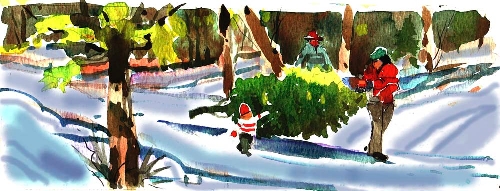Celebrate the holidays with a fresh evergreen tree

For most Americans, the nostalgic trek to the woods to cut a holiday tree exists only on Christmas cards.
The closest we come to that festive expedition is a drive to the temporarily forested tree lots that grow seasonally in every American city. But the tradition survives in parts of the country where private Christmas tree plantations allow cutting and in parts of the West where trees may be cut on forested public lands.
In Nevada, permits for cutting holiday evergreens for family use are available from the Bureau of Land Management and the Humboldt-Toiyabe National Forest in most of the state, except Clark County. Southern Nevadans must travel a few hours to other Nevada counties or to forested areas of southern Utah or northwestern Arizona to enjoy this traditional outing.
Permits for tree cutting on public lands go on sale annually in November and December. The BLM charges $4 per tree with a limit of five permits. Permits cost more on national forest lands, where the fee is $10 for a tree up to 10 feet tall and $20 for a taller tree. After paying the fee and buying food and gas for the trip, the tree you cut won’t be cheap, but the memories will be priceless.
The closest cutting areas in Nevada are in Lincoln, Esmeralda, Nye and White Pine counties. Cutting areas are primarily in mountainous terrain forested with pinyons and junipers. A few sites in Esmeralda County near Lida Summit and in White Pine County around Ely also offer higher-altitude fir trees.
Cutting areas near St. George and Cedar City in Utah are also nearby. Available trees are mostly pinyons and junipers on BLM lands and a few kinds of firs in the Dixie National Forest. Some people drive farther for a wider selection of pines and firs in cutting areas in the northern Kaibab National Forest in Arizona. When you pay for a permit, you will receive a map of cutting areas, pictures of the types of trees and instructions on how to cut and care for your tree.
Tree permits are available by mail, but most cutters opt to pick them up at forest service and BLM offices or cooperating private businesses near cutting areas. Call ahead for information and hours when tree permits will be available. For Nye and Esmeralda counties, call the BLM field office in Tonopah at 775-482-7800. For Lincoln County, contact the Caliente field office of the BLM at 775-726-8100. For White Pine County, call the forest service in Ely at 775-289-3031 or the BLM field office at 775-289-1800.
In Utah, permits are available for all southern Utah cutting areas, as well as those in northern Arizona, at the St. George Interagency Visitor Center. It is on East Riverside Drive just off Interstate 15 at the Bluff Street exit, or you can call the center at 435-688-3246. The cutting area closest to St. George is near Pine Valley. The visitor center also issues permits for the Cedar Mountain cutting areas, or you can check with the Cedar City office of the Dixie National Forest, 1789 N. Wedgewood Lane. Permits are also available at the Ace Hardware in Cedar City.
The cutting areas will be on side roads off main, paved routes. Since these are graded roads and sometimes rough, plan to use a high-clearance vehicle. There will be snow in many areas, so take tire chains. Your search for the perfect tree for your family might take you some distance from your vehicle, so keep an eye on landmarks and dress warmly in layers. Make sure your cutting tools are sharp and in good repair. Leave a stump of less than six inches.
The tree you cut will be the freshest tree you’ll ever decorate. Keep it fresh with good care. Once back home, wash down the tree with a hose, then recut the base and stand the tree in water in a sheltered place. When you bring the tree inside, frequently replenish the water in its stand. To save your floors from drips, sap and needles, set up the tree on a plastic tarp concealed by a tree skirt or white sheet. The tarp will catch debris when you take down the tree after the holidays.
Margo Bartlett Pesek’s column appears on Sundays.